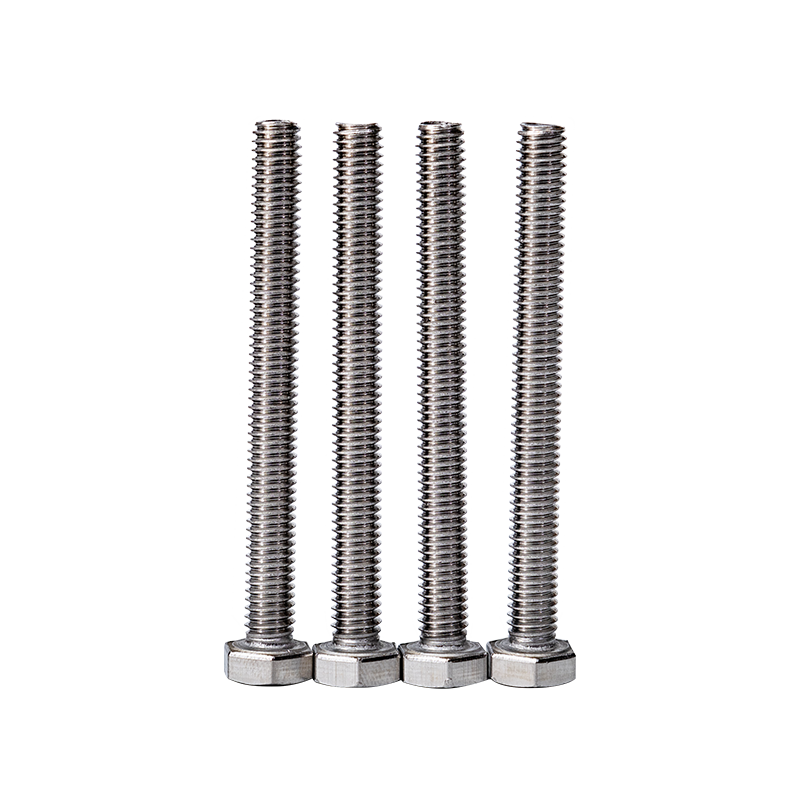The selection of stainless steel hex bolts for engineering and industrial applications requires a thorough understanding of material properties, environmental conditions, and long-term performance requirements. Among the most widely used austenitic stainless steel grades, 304 and 316 stand out due to their excellent mechanical properties, weldability, and corrosion resistance. However, their performance varies significantly depending on chemical composition and service environment. This analysis provides a detailed, technically grounded comparison to determine which grade—304 or 316—is better suited for specific applications.
1. Chemical Composition and Metallurgical Differences
The fundamental distinction between 304 and 316 stainless steel lies in alloying elements.
304 (A2 Stainless Steel): Contains 18% chromium, 8% nickel, and negligible molybdenum (typically <0.75%).
316 (A4 Stainless Steel): Contains 16–18% chromium, 10–14% nickel, and 2–3% molybdenum.
The addition of molybdenum in 316 is critical—it forms stable molybdates that enhance passive film stability on the surface, significantly improving resistance to localized corrosion, particularly pitting and crevice corrosion in chloride-rich environments. This makes 316 metallurgically superior in aggressive conditions.
2. Corrosion Resistance – Pitting and Crevice Corrosion
Corrosion resistance is the most decisive factor in bolt selection.
304 Bolts: Exhibit good resistance to atmospheric oxidation and mild organic acids. However, they are susceptible to chloride-induced pitting when exposed to saltwater, de-icing salts, or coastal atmospheres. The Pitting Resistance Equivalent Number (PREN) for 304 is approximately 18–20, calculated as:
PREN = %Cr + 3.3×%Mo + 16×%N.
316 Bolts: With a PREN of 24–30, 316 demonstrates markedly higher resistance to localized corrosion. The molybdenum content stabilizes the passive oxide layer (Cr₂O₃) against chloride ion penetration, making 316 ideal for marine, offshore, and chemical processing environments.
For applications involving seawater, brackish environments, or high humidity with salt exposure, 316 is the technically superior choice.
3. Mechanical Properties and Strength
Both grades are austenitic, non-magnetic (when annealed), and exhibit similar mechanical behavior under standard conditions.
Tensile Strength: 304 and 316 both typically range from 515 to 620 MPa.
Yield Strength (0.2% offset): Approximately 205–310 MPa.
Elongation: Both offer >40% elongation, indicating excellent ductility.
While their nominal strength values are comparable, 316 maintains structural integrity better in corrosive environments where stress corrosion cracking (SCC) may occur. In chloride-laden atmospheres, 304 bolts are more prone to SCC, especially under sustained tensile loads. Thus, 316 provides enhanced reliability in high-stress, corrosive settings.
4. High-Temperature Performance and Oxidation Resistance
At elevated temperatures, both grades resist scaling and maintain strength, but differences emerge:
304: Can withstand continuous service up to ~870°C (intermittent) but may experience sensitization (chromium carbide precipitation at grain boundaries) between 425–815°C, leading to intergranular corrosion.
316: Offers improved resistance to sensitization due to molybdenum and higher nickel content. It maintains better oxidation resistance and retains mechanical properties at higher temperatures, suitable for prolonged exposure up to 925°C.
For applications involving thermal cycling—such as exhaust systems, furnace components, or process piping—316 is preferred.
5. Cost-Benefit and Lifecycle Analysis
304 Bolts: Lower initial cost due to absence of molybdenum, which is a high-cost alloying element.
316 Bolts: Typically 20–40% more expensive than 304.
However, lifecycle cost analysis often favors 316 in corrosive environments. Premature failure of 304 bolts due to pitting or SCC can lead to unplanned downtime, maintenance, and safety risks. In critical infrastructure (e.g., offshore platforms, desalination plants), the higher upfront cost of 316 is justified by extended service life and reduced lifecycle costs.
6. Application-Specific Suitability
304 Bolts are ideal for:
Indoor structural applications
Food and beverage processing (non-saline)
Dry or mildly humid environments
Architectural fixtures with low chloride exposure
316 Bolts are essential for:
Marine and coastal installations
Chemical processing equipment (exposure to acids, chlorides)
Pharmaceutical and biotech facilities requiring high-purity, cleanable surfaces
Wastewater treatment, desalination, and offshore oil & gas
In environments where failure could lead to safety hazards or environmental damage, 316 is the standard specification.
7. Standards and Certifications
Both grades conform to international standards such as ASTM A193, A320, ISO 3506, and DIN 912. However, 316 is often specified in industries governed by stringent regulatory frameworks (e.g., ASME BPE for biopharmaceutical equipment, NORSOK for offshore oil & gas), where material traceability and corrosion resistance are non-negotiable.
Conclusion
There is no absolute answer to whether 304 or 316 is "better"—the optimal choice depends on engineering context.
304 is technically adequate and cost-efficient for general-purpose, low-corrosion environments. It remains the most widely used stainless steel globally due to its balance of performance and affordability.
316 is superior in performance-critical, corrosive environments, offering enhanced resistance to pitting, crevice corrosion, and stress corrosion cracking. Its molybdenum-enhanced microstructure provides long-term reliability where failure is not an option.
From a materials engineering perspective, 316 stainless steel hex bolts are the better choice when environmental aggressiveness, safety, and lifecycle durability are prioritized. For non-critical, dry, or indoor applications, 304 remains a technically sound and economical alternative. The decision should be based on a formal corrosion risk assessment, environmental exposure classification, and total cost of ownership—not merely initial procurement cost.




 русский
русский Español
Español عربى
عربى italiano
italiano
 No. 2 Bridge, Chuangxin Road, Dainan Town, Xinghua City, Taizhou City, Jiangsu Province
No. 2 Bridge, Chuangxin Road, Dainan Town, Xinghua City, Taizhou City, Jiangsu Province  +86-17315333748(Wechat)
+86-17315333748(Wechat)
 +86-17315333748(Wechat/Whatsapp)
+86-17315333748(Wechat/Whatsapp)

